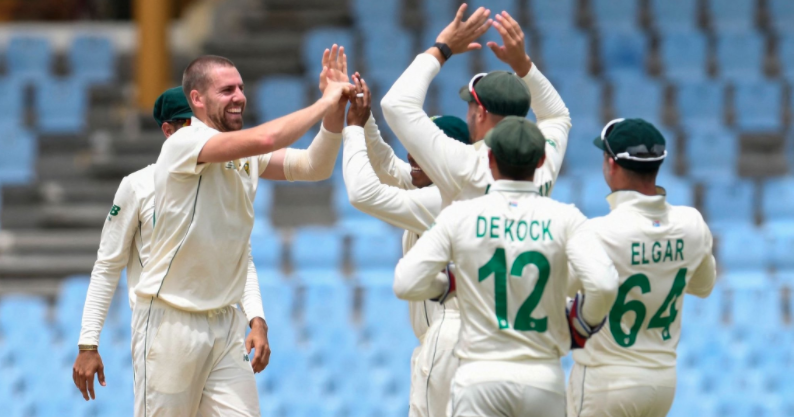The Proteas’ seamers produced a performance that was reminiscent of the high standard the country’s best attacks have set. It stirred hope of a future that will feel familiar, writes RYAN VREDE.
A Proteas’ attack has always had a fast-bowling hero – Allan Donald, Dale Steyn and Kagiso Rabada among them. However, the best Proteas pace attacks has always been defined by the strength of the collective.
There is no Donald without a Fanie de Villiers and later Shaun Pollock operating from the other end. There is no Steyn without the collective efforts of Morné Morkel and Vernon Philander. And now, for the first time in what has been an incredibly hard transition period, the first signs of a supporting cast for Rabada has emerged.
The Proteas attack, lead by the excellent Lungi Ngidi (5-19), were irrepressible through the first two sessions of the Test. And it clicked without much notice. There have been some good individual bowling performances since Mark Boucher took charge of this team in late 2019. However, the collective efforts have often been infuriatingly toothless.
This, was different. This was worth getting excited about because featured a pace foursome with a clear plan, a plan given life by the excellent execution thereof. The unrelenting consistency with which the pace attack plugged their lines and lengths created pressure. Their pace, movement off the deck, swing through the air and aggression compounded that pressure.
That they did all this in partnerships that never relinquished their grip broke the Windies’ resistance. The hosts had no response and were dismissed for their lowest-ever Test total against South Africa. It was a masterclass in the power of fast bowling in clinical collaboration.
That Rabada, the most experienced and potent of the foursome, played a supporting role in the innings is yet more reason for optimism. He hasn’t taken a five-for in his last 17 Tests dating back to March 2018.
His performances overall have waned, particularly after the retirement of new-ball partner Vernon Philander, who’s combination of wicket-threat and economy created pressure that Rabada benefitted greatly from. There were signs of a return to form in Gros Islet, and he will once again be the most potent threat. But it was Ngidi’s day, and also one for the catalytic force that is Anrich Nortje (4-35).
Nortje, if he remains fit, will take over 200 Test wickets for South Africa, such is the depth of his talent and temperament. He is just 27 years old and, if the careers of the modern era’s elite are anything to go by, still has some way to go before he gets close to the ceiling of his potential.
Wiaan Mulder, having played just four Tests at just 23 years old, is closer to the basement of his potential than its ceiling. He is a huge talent who has x-factor. Time will reveal whether he has the temperament to match that talent. In the context of this pace attack, he looks a good fit.
And even though this is a celebration of the seamers, it would be remiss to underestimate Keshav Maharaj’s contribution.
Indeed, this is what a Proteas pace attack used to feel like on it’s best days.
However, to announce the dawn of a new era in South African fast bowling is premature. They’ve had a great day. They will need to have many, many more of those in the coming months and years to warrant comparison with some of the best pace attacks in Proteas history. But you would have to be wilfully blind to dismiss this unit as mere bullies of a weak West Indies batting line-up.
It speaks volumes about the importance of a collective contribution that the two teams contesting the World Test Championship final, New Zealand and India, boast 10 of the world’s top 20-ranked Test bowlers (eight of the 10 are seamers).
One man carrying an attack has and will never place a team among the game’s elite. Therein lies the joy in the Proteas’ pacemen’s work on day one.







